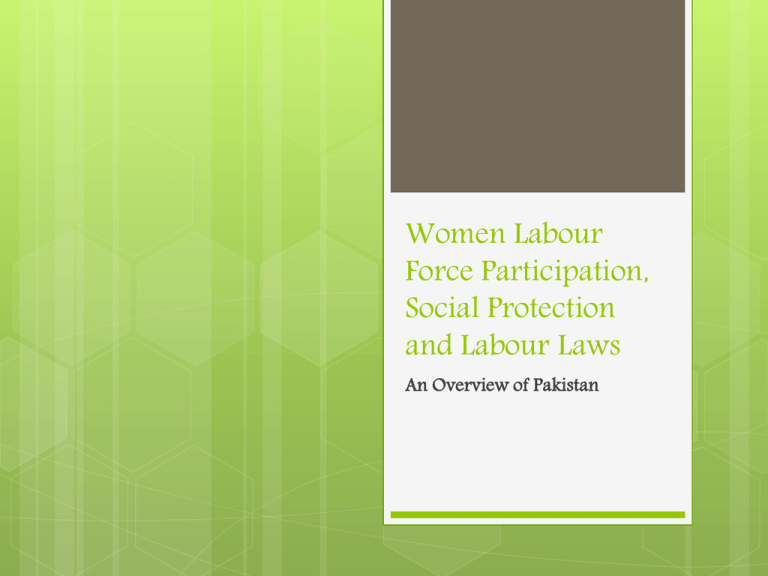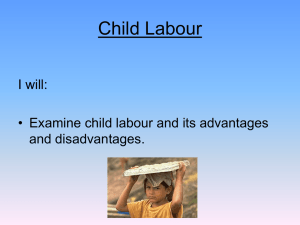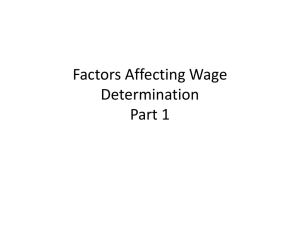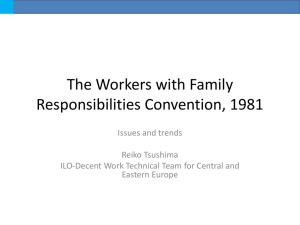
Women Labour
Force Participation,
Social Protection
and Labour Laws
An Overview of Pakistan
The Context:
Labour Force Participation Trends in
Pakistan
Overall Labour force participation rates in the last
ten years:
1999-2000
–
50.4%
2006-2007
–
52.5%
2010 – 2011
53.4%
Gender wise labour force participation rates:
Males 2010 – 2011
– 81.9%
Females 2010 – 2011
- 24.4%
The employment to population ratio has steadily
increased over the last ten years from 46.8% in 1999 –
2000 to 50.4% in 2010 to 2011;
This is especially applicable in case of women
increasing from 13.7% in 1999 – 2000 to 22.2% in
2010 – 2011;
But, men seem to benefit more from improvement in
the labour market. In 2010-2011, the share of men
with a wage and salaried job was at 41.2% almost
double that of females at 21.6%.
Roughly six out of ten employed people in Pakistan
(61.6 percent) in 2010- 2011 were considered to be
vulnerable, meaning “at risk of lacking decent work”;
The large share of female vulnerability (78.3 percent)
needs special attention;
Pakistan has seen very low labour productivity over
the last decade. In addition the relatively low growth
in labour productivity has not gone hand in hand with
the increasing labour force and employment growth;
Most new labour market entrants are taking on lowproductivity, poorly remunerated work.
Despite recent gains in terms of employment and
unemployment, the reviewed labour market indicators
highlight the gender gap:
Women continue to be underutilized in the economy and
labour market as reflected in their overall participation, as
well as in the distributions in terms of economic sector and
status groups;
In line with the trend since 1999-2000, the proportion of
women in the status group of wage and salaried workers
decreased in the recent survey years. Less than a quarter of
all women are now in a salaried position, as compared to a
third at the beginning of the decade.
The New MDG Targets
According to ILO’s recent labour market
framework, “There is no single solution to
wiping out poverty. But “full and productive
employment and decent work for all,
including women and young persons” – the
promotion of rights, employment, social
protection and dialogue- needs to be the
heart of successful policies to get there.”
The endorsement of decent work has also become a top
priority of the Government of Pakistan as reflected in a
number of national policy documents, some of which are:
The Medium Term Development Framework (MTDF)
for 2005-2010,
Documents related to employment creation (Labour
and Employment Policies),
Poverty reduction (Poverty Reduction Strategy Papers)
and;
Human resource development (Skilling Pakistan)
Women’s Labour Rights and Pakistan’s
Constitution
Pakistan’s Constitution and labor laws provide equal opportunities
regardless of gender, caste or creed as well as laws permeating
regulations and benefits covering minimum wages, social security,
health coverage and old age benefits;
The Constitution of 1973, in its Principles of Policy section,
declares that “steps shall be taken to ensure full participation of
women in all spheres of national life” (Article 34);
Article 37 (e) of the Constitution says, “The State shall make
provisions for securing just and humane conditions of work
ensuring that children and women are not employed in vocations
unsuited to their age or sex and for maternity benefits for women
in employment.”
Overview of Labour Laws
Pakistan’s labour laws have been inherited from India
although adjusted with time according to needs;
Pakistan has more than 70 laws related to labour
issues.
Labour is regarded as a ‘concurrent subject’, which
means that it is the responsibility of both Federal and
Provincial Governments;
For uniformity, laws are enacted by the Federal
Government, stipulating that Provincial Governments
make rules and regulations according to the
prevailing conditions or requirements of a Province.
Specific laws and by-laws for various terms of employment;
For example contract of employment whereby establishing a
relationship between the employer and employee through a
contract of employment;
The Ordinance applies to all industrial and commercial
establishments throughout the country employing 20 or
more workers and provides for security of employment;
In case of informal or casual workers like domestic workers,
farm workers or daily wagers, labour contracts are
undocumented and can be enforced through the courts on
the basis of oral evidence or past practices.
Services
of a permanent worker cannot be
terminated unless other than misconduct without
one month’s notice or wages in lieu thereof has
been furnished by the employer or by the worker
if he or she chooses to leave his or her service.
The law also covers working time and rest time
(Factories Act 1934), minimum age of the worker
(Article 11(3)), paid leave provision (Factories Act
1934), maternity leave and maternity protection
(Article 37).
Women and Labour Laws
There
are no women specific labour laws
except the right to a maternity leave;
There is also a law that women and children
in the labour force have the right to less
work hours;
Recently, the government has enacted a new
law to make provisions for protection of
women against harassment at the
workplace.
Conclusions
According to the Pakistan Labour Laws health is a human
rights issue thus the responsibility of the State. Certain areas
of RH are included in the Labour Laws, but there is no
awareness amongst the employers or the workers about
these provisions in the law;
There are no provisions in the law for post-delivery
conditions, like breast feeding mothers. Mothers with small
children have no concessions or any spaces provided as
baby crèches as a result women with young children are
forced to abandon their work;
Women of reproductive ages are discriminated against by
employers who fear that they will not be able to deliver as
much as required;
Enforcement
and compliance issues
especially at the provincial level;
No accountability mechanisms to keep a
check on the enforcement of laws at any
level and neither does it seem to be a
priority at the State level;
Recommendations
The existing labour laws need to be reviewed and repealed to address specific
needs of women workers. This should not only apply to just maternity leaves but
a more holistic view of the women’s reproductive needs as a recognized and
integral part of all labour laws considering women have equal rights according
to the Country’s Constitution;
Gender sensitization across board is essential to break the patriarchal mindset
starting from inclusion of RH and gender issues in the school curriculums;
There is a definite need to factor in the informal sector which constitutes
majority of the labour force of the country including women in the legal
framework;
The Government needs to regulate and monitor the private sector which at
present is out of the country legal loop;
Cultural and social context needs to be kept in mind while formulating policies
and laws, which can even vary regionally;







